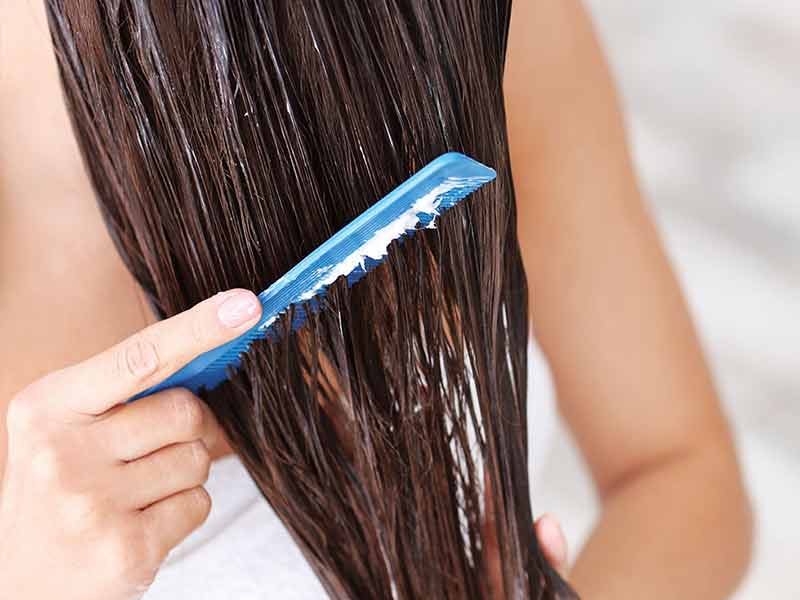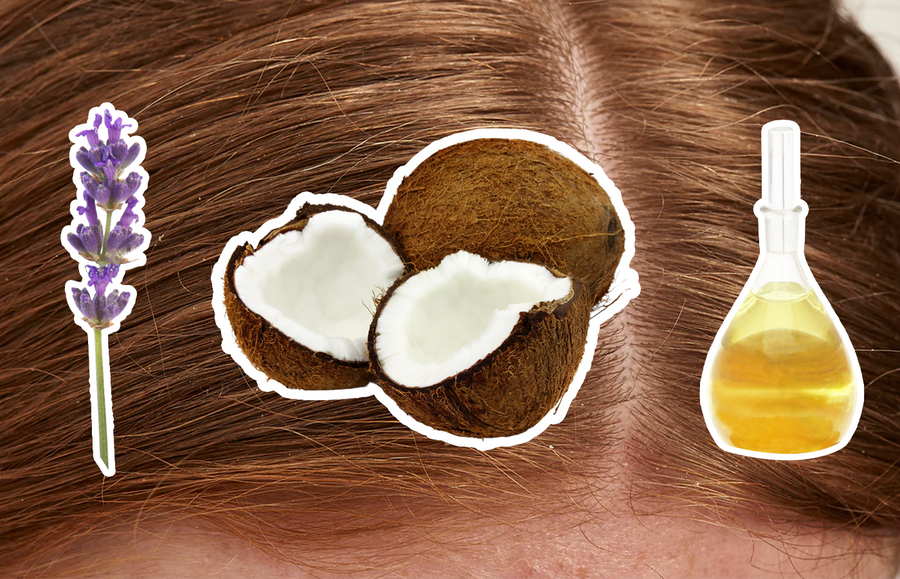Introduction
Coconut oil has garnered acclaim for its multifaceted role in beauty and health regimens, particularly for hair care. Its ability to impart a lustrous sheen and deeply condition the scalp and strands makes it a favorite among hair enthusiasts seeking a natural treatment.
However, despite its numerous benefits, coconut oil presents a unique challenge when it comes to removal. The oil’s tenacious nature means that a simple shampooing may not suffice, leaving many to wonder how to effectively rinse coconut oil out of hair without leaving behind a greasy residue.
Understanding the proper techniques to eliminate coconut oil from your hair is crucial for maintaining scalp health and avoiding issues such as clogged pores or excessive oiliness.

This guide will walk you through the steps to thoroughly rinse coconut oil out of your hair, ensuring that you can continue to enjoy the advantages of this natural wonder without any unwanted side effects. From preparation to the final rinse, we’ll cover all the essentials for a clean, refreshed mane.
Why rinse coconut oil out of hair?
While coconut oil is celebrated for its nourishing properties, it’s essential to rinse it out properly to prevent potential drawbacks. Excessive coconut oil can lead to an oily scalp, attract dust, and even cause hair to appear greasy, particularly in those with finer hair textures.
Moreover, if left unchecked, coconut oil can accumulate, clog pores, and stifle hair follicles, escalating the risk of hair fall. Therefore, it’s imperative to strike a balance by removing coconut oil after it has served its purpose of conditioning and moisturizing your hair.
Experts advise that although coconut oil can enhance hair health by minimizing protein loss and boosting moisture, it’s counterproductive if not washed out correctly.
An overstay of coconut oil on your locks can create a buildup that not only weighs down your hair but also attracts dirt and dust, which can be detrimental to both the appearance and health of your hair.
Hence, learning how to rinse coconut oil out of hair effectively is a critical step in harnessing its benefits while maintaining clean, vibrant, and healthy hair.
Preparation for rinsing coconut oil out of hair

Brush your hair
Before you begin the process of rinsing coconut oil out of your hair, it’s important to prepare your locks to ensure the oil can be removed efficiently. Start by gently brushing your hair with a natural bristled brush, if available.
This helps to evenly distribute the coconut oil throughout your hair, from the roots to the tips, which can aid in the rinsing process. Brushing not only detangles your hair but also stimulates the scalp, increasing blood circulation and promoting healthier hair growth.
Remember to brush in a downward motion to add extra volume and prepare your hair for the subsequent rinsing steps.
Properly brushed hair can make a significant difference in how easily the coconut oil is removed. By detangling and smoothing your strands, you reduce the risk of breakage and ensure that the shampoo and water can reach every part of your hair during the rinsing process.
This preparation step is a simple yet effective way to enhance the overall effectiveness of your hair rinsing routine, setting the stage for a cleaner, oil-free mane.
Prepare warm water
Once your hair is thoroughly brushed and ready, the next step in your coconut oil removal routine is to prepare warm water.
Warm water plays a crucial role in the rinsing process as it helps to melt and break down the coconut oil, making it easier to wash out.
Ensure the water is not too hot, as extreme temperatures can damage your hair and scalp. Aim for a comfortable warmth that you can sustain for a few minutes, as this will effectively soften the coconut oil without causing any discomfort or harm.
It’s important to note that while warm water aids in dissolving coconut oil, it’s not enough to remove it completely. The warmth helps open up the hair cuticles, allowing the shampoo and other treatments to penetrate more deeply and cleanse the hair.
This preparation step is essential for a successful rinse, setting the foundation for the cleansing agents to work their magic and leave your hair feeling clean and refreshed.
Rinsing coconut oil out of hair

Use a gentle shampoo
Transitioning to the actual rinsing phase, selecting a gentle shampoo is paramount when it comes to effectively removing coconut oil from your hair. Opt for a shampoo that is designed to cleanse without stripping hair of its natural moisture, as harsh formulas can exacerbate dryness and cause irritation.
A mild shampoo will work in harmony with the warm water, further breaking down the coconut oil without damaging your hair.
For an added boost, consider mixing in a teaspoon of aloe vera gel with your shampoo, as suggested by experts, to enhance the moisturizing properties and ensure a thorough cleanse.
When applying the shampoo, focus on massaging it into your scalp and throughout your hair to emulsify the coconut oil. This step is crucial as it ensures that the shampoo reaches all areas affected by the oil, allowing for a comprehensive clean.
The goal is to lift the oil from your strands and scalp gently, so take your time working the shampoo through your hair.
A thorough massage will also stimulate the scalp, promoting healthy hair growth and ensuring that no residue is left behind. Remember, patience and a gentle touch are key to effectively rinsing coconut oil out of your hair.
Massage the shampoo into your scalp
With the right shampoo at hand, it’s time to focus on the technique of massaging it into your scalp to remove the coconut oil. Start by applying a generous amount of shampoo to your palms and gently work it into your scalp with your fingertips.
Use circular motions to distribute the shampoo evenly, ensuring that you cover all areas where the coconut oil has been applied. This massaging action not only helps to break down the oil but also boosts circulation to the scalp, which is beneficial for hair health.
Continue to massage the shampoo through the lengths of your hair, paying extra attention to areas with a heavier concentration of coconut oil. The combination of warm water and the emulsifying action of the shampoo will begin to lift the oil from your hair.
It’s important to be thorough yet gentle to avoid tangling and stressing the hair strands. After a few minutes of massaging, you’ll be ready to rinse thoroughly, ensuring that all traces of coconut oil and shampoo are washed away, leaving your hair clean and revitalized.
Rinse thoroughly
Once you’ve massaged the shampoo into your scalp and hair, the next step is to rinse thoroughly. This is a critical stage in the process of removing coconut oil from your hair. Use warm water to wash away the shampoo, as it helps in dissolving the oil more effectively.
Ensure that the water flows through all parts of your hair, from the roots to the tips. It’s essential to take your time during this step to make sure that no residue of coconut oil or shampoo remains, as this could leave your hair feeling greasy or heavy.
As you rinse, you may notice the water becoming milky or cloudy – this is a good sign that the coconut oil is being washed out. If your hair still feels slick after the initial rinse, don’t hesitate to apply a second round of shampoo and repeat the process.
A thorough rinse not only prevents build-up but also avoids unnecessary stress on your hair and scalp. Remember, over-rinsing can be just as harmful as not rinsing enough, so once the water runs clear and your hair feels clean, it’s time to stop.
Conditioning after rinsing coconut oil out of hair

Apply conditioner to the ends of your hair
After successfully rinsing out the coconut oil and shampoo, it’s time to condition your hair to restore moisture and smoothness. Apply a generous amount of your favorite conditioner, focusing on the ends of your hair where dryness is most common.
The conditioner acts as an emulsifier, further aiding in the removal of any lingering coconut oil residue while providing deep nourishment. Allow the conditioner to sit for a few minutes, as this will help to detangle and soften the hair, making it easier to manage post-shower.
When applying conditioner, start from the mid-lengths and work your way down to the tips, avoiding the scalp to prevent any potential greasiness. This targeted application ensures that the most damaged and dry areas of your hair receive the hydration they need.
After a few minutes, rinse out the conditioner with cool water, which helps to seal the hair cuticles and enhance shine. This step is crucial for achieving that silky, healthy-looking hair after the intensive coconut oil treatment.
Rinse out the conditioner
Once the conditioner has had time to work its magic, begin rinsing it out with cool water. This step is vital to ensure that your hair retains the moisture and benefits from the conditioner without leaving any residue that could weigh your hair down.
Cool water is particularly effective as it helps to close the hair cuticles, locking in the moisture and leaving your hair with a lustrous sheen. Make sure to rinse thoroughly, as any remaining conditioner mixed with coconut oil could leave your hair feeling heavy and looking limp.
As you rinse, gently run your fingers through your hair to help remove the conditioner evenly. This also helps to detangle your hair and ensure that each strand is free from excess product. A final rinse with a blast of cool water can invigorate the scalp and give your hair an extra boost of shine.
Once the water runs clear and your hair feels smooth without any slipperiness, you’ll know you’ve rinsed out the conditioner completely, setting the stage for healthy, revitalized hair.
Drying and styling your hair after rinsing coconut oil
With the coconut oil and conditioner thoroughly rinsed out, it’s time to gently dry your hair. Pat your hair with a soft towel to remove excess water without causing friction that can lead to frizz or damage.
For those with fine hair, it’s especially important to avoid aggressive rubbing, as this can exacerbate oiliness and reduce volume.
Once towel-dried, you can opt for air-drying to minimize heat exposure or use a blow dryer on a low heat setting to prevent further stress on your strands. If you choose to blow dry, remember to brush your hair downward from the roots, as this technique adds extra volume and prepares your hair for styling.
When your hair is dry, styling can be approached with a fresh perspective. If you’re aiming for a voluminous look, consider using a dry shampoo like Klorane for an added lift at the roots and a texturizing effect.
For those who prefer a sleeker appearance, a natural bristled brush can help achieve a smooth finish. Regardless of the style you choose, your hair should now be free of coconut oil, feeling clean, and looking vibrant.
Remember, the key to maintaining healthy hair is to balance treatments like coconut oil with proper removal techniques to avoid buildup and ensure your hair remains in optimal condition.
Conclusion

In conclusion, successfully rinsing coconut oil out of your hair requires a methodical approach, from preparation to the final rinse. By following the steps outlined, you can enjoy the numerous benefits of coconut oil without the drawbacks of residue or heaviness.
It’s essential to use a gentle shampoo, thoroughly massage and rinse, and follow up with a conditioner that doesn’t counteract your efforts.
The final touch of drying and styling should leave your hair feeling refreshed and full of life. With these tips, you can incorporate coconut oil into your hair care routine confidently, knowing you have the know-how to remove it effectively, keeping your hair healthy and radiant.
Remember, while coconut oil can be a fantastic addition to your hair care regimen, it’s crucial to understand the proper techniques for its removal to maintain the balance of your hair’s natural oils and avoid any potential issues.
By mastering the art of rinsing coconut oil out of your hair, you ensure that your locks remain nourished and beautiful, ready to face the day with a natural glow and vitality that only proper care can provide.
Sources:
- https://www.quora.com/How-do-I-wash-off-coconut-oil-from-hair-daily-without-shampoo
- https://www.stylecraze.com/articles/how-to-wash-coconut-oil-out-of-hair/
- https://bellatory.com/hair/How-to-Get-Coconut-Oil-Out-of-Hair-Without-Ruining-Your-Scalp
- https://cools.com/coconut-oil-for-hair
FAQ
How do you remove oil from hair after oiling it?
Apple cider vinegar, aloe vera, baking soda, rice water, lemon juice and cornstarch can all aid in effectively removing excess oil from your hair.
How do you get rid of oil build up in your hair?
Wash more often, wash less often, shampoo properly, condition carefully, go natural, use products formulated for oily hair, clean your brush, deep clean with aloe.
How do you get oil out of your hair without shampooing it?
Dry Shampoo, Tease Your Locks, Quick Blow Dry, Blotting Paper, Toner, Aloe Vera, Rice Water, Corn Starch.
How do you use coconut oil to remove hair?
Allow the coconut oil to sink in and soften the skin. You can also use coconut oil in this way as a pre-shaving treatment and apply another cream or soap on top of it. Rinse your razor frequently to keep the coconut oil from building up on it. Rinse your skin with warm water or wipe it gently with a soft, warm towel.
Originally posted 2023-12-08 09:37:01.

